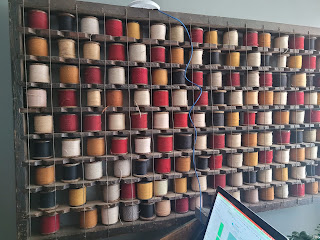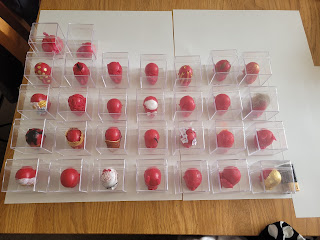The Situation
I arrived at the CSM Postgraduate Show in high spirits today. I went last year and enjoyed it, and I had seen others go, and was excited to go too. I left feeling cheated, sad, and weirdly angry. These were not necessarily rational responses, but this blog post attempts to understand and reflect on this.
Before I begin, two disclaimers 1) I DID like some of the art, I'm not going to say which, but if you are reading this and you exhibited, please consider my reasoning and see if you think it applies to your art, if you think it doesn't, then I either didn't mean your art, or I misunderstood it 2) I had to be up at 0430 this morning so while I didn't feel tired, I was probably quite tired and grumpy (my late wife always use to check how much sleep I had had before listening to any rant about work).
Please remember the aim of this post is not to critique and pull-apart the CSM show, it's to understand my reaction to it, and what it might mean for me, my understanding of art, and how I approach art in the future.
What did I feel before?
- Excited
- Anticipation to see some cool art
- Excitement to find which pieces spoke to me
- Trepidation that I need to fit into this next year
- Curiosity for what was there
- Excitement to meet some artists
- Resentful
- Depressed
- Angry (with a small 'a')
- Cheated
- Rejected
- Isolated
- Keen to think about my own work and how it compared
- Keen to think about how to display my work
Looking at this, there's perhaps 3 clusters of emotions - primary responses to what I saw, secondary responses to what the experience triggered in me, and practical responses.
The two practical responses can be set aside for later. I need to think about what practical changes I will make as a result of this experience.
Having not come from an artistic background, and having had fairly humble beginnings, where I was exposed to a lot of folk art, but not 'culture', I am probably over-sensitive to not 'fitting in' or 'being accepted'. I suspect we can remove 'resentful', 'rejected' and 'isolated' from the list because they are to do with me and my hangups, not what I was experiencing.
This leaves us with 'depressed', 'angry' and 'cheated'. Of these, 'cheated', is probably the most useful. Feeling 'cheated' suggests I didn't get something from the list of things I was expecting. Based on the 'before' list, and my recollection of where things started to 'go wrong', I think I felt cheated because I didn't like most of the art.
What's my problem?
When I consider my own art, I consider balancing three things (I bet there is a 'official' version of this with more!):
- Meaning: Does this piece mean something, does it talk about something interesting, is it thought-provoking? Does it make me think about it in the shower days later?
- Skill/Effort: Does this piece look like care went into it? Does it show skill to make it? Does it show prolonged effort to make? Was it made over a meaningful timescale? Does it look like the artist cared? Do I admire the effort?
- Beauty: Is it beautiful or intricate, does it make me want to look at it, does it give up details in a graceful way? Would I want to have it in my home? Would I want to have a photo?
I think of these as being 'points' on a triangle - the less you have of one, the more you need of the others - you can get away with being a bit shabby if you are charming and interesting, you can get away with being a bit shallow if you are well-made and easy on the eye, you can get away with being kinda ugly if you are interesting and made an effort. What you can't be is shabby, shallow, and ugly (as a piece of art, at least). I consider myself very lead by concept, so I would put meaning above the others - to be, right now, it doesn't matter how skilful or beautiful something is, it has to mean something.
Reflecting, plus looking at notes I took immediately afterwards, I had the following 'issues' with what I saw:
- Meaning: I found a lot of the art hard to understand. Clearly that could be my fault, but equally it suggests to me that either there was no meaning, or the meaning wasn't clear enough
- Skill: A lot of the pieces looked, well, sort of thrown-together. That might reflect the situation it was made under, or it might reflect an aesthetic choice. It felt like there was a focus on experimentation at the expense of finish. As someone with conceptual leanings, I don't think art needs to be a demonstration of skill - that's craft arguably - but it feels like it should look like it took some effort to construct. I think a lot of the public criticism of modern art is that it looks like it was made in half-an-hour by someone with a cup of coffee in one hand and a joint in the other.
- Beauty: A lot of the art was quite loud and garish for my taste. The seemed to be a lot of bright colours and aggressive contrasts.
- Scale: A lot of the pieces where BIG... But it felt like this was done because it's 'good' to go big... The scale didn't seem to add much to many pieces, and just felt wasteful. To me, scale needs to have a purpose.
- Detail: Maybe this is a personal sensibility, but few pieces seemed to reward closer inspection - you got a face full, but looking closer revealed nothing new
I'm definitely not claiming to have any of the above sewn-up, but I equally think that doesn't mean I can't have an opinion. I'm not saying any of those things were RIGHT, just that I FELT them. There were definitely a few pieces that were AMAZING, but I sort of expected a lot more.
I think the environment provided a number of challenges that I need to consider carefully for when my own time comes:
- Crammed in: There felt like a LOT of art in a fairly small space. Some pieces seemed to have been given a corner, while others were allowed to sprawl everywhere. It was sometimes hard to see where once piece finished and another started, creating odd 'composite' artworks that were presumably unintended
- Performance art: I love performance art, but some of the pieces were actually intended to be performances, and it wasn't always clear. Several pieces I couldn't understand turn out to be props for performances. It felt like it should be clearer what stood alone, and what was supposed to be 'performed'. Ironically I learnt that one of my favourite pieces was actually part of a performance, which I missed, but which sounded even more amazing!
- Dead Electronics: A lot of pieces featured electronics, the majority of which were either broken or not turned on
- No explanations: There were labels, but they seemed quite inconsistent - some did explain the work, giving some chance to 'rescue' works that were hard to read. Some were very plane, some were filled with art-speak that used a lot words to not really say much
- Show not an exhibition: Someone pointed out that I was being unfair going to a show and expecting an exhibition. Now I better understand the difference I should have been prepared to treat it more as a bazaar than a cathedral.
- A snapshot of a bigger practice: Of course I was seeing a tiny curated amount of work from 2 years, and it was tempting to think of it as being the culmination of those 2 years, but it was probably closer to a sample - different people probably gave themselves different criteria for deciding what that was - some might have gone for recency, some for quality, some for the most representative.
So would I have felt like this if I had more sleep? Maybe. Either way, I felt what I felt, so what does it mean for me?
What am I going to do about it?
I don't think I should build my art practice around one show, but I do need to consider carefully what I choose to show, and how. I think to succeed in a such an environment, I want to make work that:
- Draws people over to it by being 'interesting' from a distance, I want people to see at a glance there is something 'going on'
- Defends it's boundaries - I have no idea what that means in practice - but I have to assume I am going to be displayed in a dark corner between a six foot inflatable headless duck and a 3 m by 3 m neon pop art print of someone's arse crack
- Offers something immediately graspable in terms of meaning - having come over to see what is 'going on', there needs to be something clearly 'going on'
- Rewards inspection by offering lots of detail and intricacies not apparent at a distance
- Rewards inspection by offering layers of meaning
- Leaves the viewer with a mental after-glow that comes back to haunt them when they are trying to sleep that night







